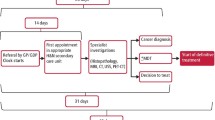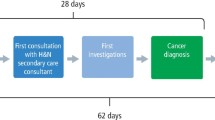Abstract
Introduction It is not uncommon to note patients with painful orofacial lesions presenting via the emergency department to the on-call team. However, during the COVID-19 pandemic, we saw a surge in these attendances, prompting a review of our emergency database.
Methods The maxillofacial emergency database was retrospectively reviewed in the period between March 2020 and October 2021 (19 months). Data including relevant variables were collected in a standard spreadsheet database and analysed by two clinicians.
Results Between March 2020 and October 2021, 34 patients attended with oral ulceration and non-odontogenic neck swellings, out of which nine patients had subsequent diagnosis of oral/oropharyngeal cancer (mean age: 64.2 years). All patients were grouped as stage IV cancers and only one patient was deemed suitable for ablative surgery, which is the primary mode of treatment in oral cancers. Three patients were deemed to have progressive/recurrent disease despite active treatment and two patients unfortunately passed away due to the disease.
Conclusion The impact of the COVID-19 pandemic on head and neck cancer diagnoses and management suffered significantly. We present our experience dealing with this vulnerable cohort in the emergency department and their subsequent journey.
Key points
-
The COVID-19 pandemic has caused immense calamity to our healthcare system and its effects on the vulnerable population cannot be overemphasised. Many patients struggled to access clinical care during this time, with state-mandated lockdown adding more damage to the perilous situation.
-
A significant increase in head and neck cancer cases was noted to be coming through the emergency department during the pandemic. It was noted that almost 1:5 cancer diagnoses occurred after a patient presented themselves to the accident and emergency department.
-
All these patients were in the highest stage of their disease and about one-third of these patients were noted to have progressive or recurrent disease, and two more patients unfortunately passed away due to this unforgiving disease. We describe a retrospective review to understand these attendances and their eventual outcome.
Similar content being viewed by others
Background
Head and neck cancer (HNC) incidence is on the rise in the UK and globally, with up to a 16% increase in the past decade.1There is evidence to suggest that these cancers have relatively higher upstaging risk due to shorter volume doubling time.2 The COVID-19 pandemic has caused immeasurable tragedy to all and especially those with malignancies. Patients with non-resolving oral lesions were unable to access adequate primary care and those with previous HNC were not adequately followed-up in secondary care due to the global pandemic, which made its first appearance in January 2020 in the UK.3 Various preventative methods were introduced to triage patients and avoid delayed diagnoses and treatment to patients at risk of developing HNC.4
Methods
Our dedicated maxillofacial emergency database provided data related to patients attending the emergency department (ED). We retrospectively collected data from the period between March 2020 and October 2021, which coincided with the different peaks and phases of the COVID-19 pandemic in the UK. We included only proven malignant lesions, excluding patients who attended with, and formally diagnosed with, benign entities. The data were referenced with available histopathology records and electronic patient records to confirm diagnoses and outcomes.
Results
A total of 2,774 patients were recorded on the maxillofacial emergency database of our North London teaching hospital (Table 1). In total, 34 patients presented with oral ulceration and non-odontogenic neck swellings and nine patients were subsequently diagnosed to have HNC. More than two-thirds of the patients were men (67%) and their ages ranged between 41-89 years (average: 64.22 years; median 63.61 years). More than half of the cohort were white and the rest comprised of people of Asian, Romanian and Bulgarian descent. Eight patients presented with persistent or non-resolving oral 'swellings' and one patient presented with a painful neck swelling.
All patients underwent diagnostic biopsies between 0-17 days (average seven days) after first review in ED. None of the patients were delayed as per the recommended waiting targets for the suspicious head and neck cancer pathway. All patients were graded to have stage IV cancers and only one patient had ablative surgery which is standard treatment for oral cancers.5 One-third of patients (n = 3) had recurrent or progressive disease and two patients died due to the destructive disease.
Discussion
The UK NHS EDs noted a significant drop in patients during the lockdown period by about 50%.6 Of those patients attending ED, the majority were due to severe COVID-19-related symptoms. The lockdown also meant that many patients were asked to self-isolate and quarantine away from their families and consequently received reduced access to help and medical services. There was significant collateral damage to other patient groups, including patients with new malignancies or previous HNC. Referrals via the two-week wait pathway for suspicious HNCs reduced by 84% during the initial lockdown period.7
A total of 54 patients were diagnosed with HNC in our unit during the period between March 2020 and October 2021 and 17% (n = 9) of these patients attended via the ED. Although the cohort is small, the staging and extent of disease is alarming. It is therefore inferred that the lack of access to essential/urgent care services during the COVID-19 pandemic and consequent reduction in referrals via the two-week wait clinics were likely causes of this presentation in the emergency department. It is also understood that there was inherent fear among patients to venture out or seek help, even when problems or symptoms occurred.
Metzger et al. noted higher pathological tumour staging in newly diagnosed cancer patients during the COVID-19 pandemic.8 Similar findings were noted in patients presenting sinonasal malignancies during this period.9 Although our cohort is small, it represents the trends noted in other countries and institutions dealing with similar patients and entities.
Conclusion
We have presented our findings related to oral/oropharyngeal malignancies presenting as maxillofacial emergencies during these unprecedented times. Our aim is to promote safe, robust triaging and early assessment by providing all possible means of support to this vulnerable cohort, especially in this unpredictable climate.
References
Cancer Research UK. Head and neck cancer statistics. Available at https://www.cancerresearchuk.org/health-professional/cancer-statistics/statistics-by-cancer-type/head-and-neck-cancers#heading-Zero (accessed December 2021).
COVIDSurg Collaborative. Head and neck cancer surgery during the COVID-19 pandemic: An international, multicentre, observational cohort study. Cancer 2021; 127: 2476-2488.
Lillie P J, Samson A, Li A et al. Novel coronavirus disease (Covid-19): The first two patients in the UK with person to person transmission. J Infect 2020; 80: 578-606.
Singh M, Ghaly G, Mumtaz S, Hughes C, Thomas S. Triaging algorithm for head & neck oncology follow-up patients in COVID-19 climate. Surgeon 2021; 19: 33-36.
World Health Organization. TNM classification of carcinomas of the lip and oral cavity. Available at https://screening.iarc.fr/atlasoralclassiftnm.php (accessed November 2021).
NHS England. A&E Attendances and Emergency Admissions. 2020. Available at https://www.england.nhs.uk/statistics/statistical-work-areas/ae-waiting-times-and-activity/ (accessed July 2022).
Sud A, Torr B, Jones M E et al. Effect of delays in the 2-week-wait cancer referral pathway during the COVID-19 pandemic on cancer survival in the UK: a modelling study. Lancet Oncol 2020; 21: 1035-1044.
Metzger K, Mrosek J, Zittel S et al. Treatment delay and tumour size in patients with oral cancer during the first year of the COVID-19 pandemic. Head Neck 2021; 43: 3493-3497.
Meerwein C M, Stadler T M, Balermpas P, Soyka M B, Holzmann D. Diagnostic pathway and stage migration of sinonasal malignancies in the era of the COVID-19 pandemic. Laryngoscope Investig Otolaryngol 2021; 6: 904-910.
Author information
Authors and Affiliations
Contributions
Harriet Stringer and Shadaab Mumtaz contributed to the conception and design of the study, acquisition of data, analysis and interpretation of data, drafted the article and critically revised and gave final approval of the manuscript. Noor Mohammad contributed to acquisition of data and gave final approval of the manuscript. Deepak Komath contributed to analysis and interpretation of data and gave final approval of the manuscript.
Corresponding author
Ethics declarations
The authors declare no conflicts of interest.
We used the NHS Health Authority MREC system to check if our project would be considered as research and if ethical approval was required. However, this project did not amount to be considered as research and hence ethical approval was not required.
Rights and permissions
About this article
Cite this article
Stringer, H., Mohammad, N., Mumtaz, S. et al. Head and neck cancer presentations in the emergency department during the COVID-19 pandemic. Br Dent J (2022). https://doi.org/10.1038/s41415-022-4505-2
Received:
Accepted:
Published:
DOI: https://doi.org/10.1038/s41415-022-4505-2
This article is cited by
-
Forestalling collateral damage
British Dental Journal (2022)



